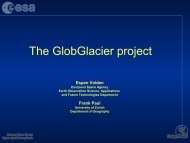proportion
Altai - GLIMS: Global Land Ice Measurements from Space
Altai - GLIMS: Global Land Ice Measurements from Space
- No tags were found...
Create successful ePaper yourself
Turn your PDF publications into a flip-book with our unique Google optimized e-Paper software.
D16107SHAHGEDANOVA ET AL.: GLACIER AND CLIMATE CHANGE IN THE ALTAID16107ably with RCM performance in the Alps [Frei et al., 2003;Schmidli et al., 2007] and in the Caucasus [Shahgedanova etal., 2009]. The July–August precipitation underestimated bythe model has limited impact on accumulation in the studyregion. Snowfalls do not occur on the Aktru glaciers whenair temperatures exceed 5°C at the Kara‐Tyurek station[Narozhny and Adamenko, 2000] and these have been consistentlyabove the threshold after the 1980s (Figure 5c).Therefore, the developed projections can be used in assessmentof changes in annual precipitation affecting accumulationbetween the baseline period and 2071–2100. PRECISintegrations for 2071–2100 indicate that JJA air temperatureswill increase by 6–7°C and 3–5°C under the A2 and B2 groupof SRES CO 2 emission scenarios in comparison with thebaseline period of 1961–1990 (Figure 6c). Annual precipitationis projected to increase by 15% and 5% respectively(Figure 6d) with the largest increase in November–Decemberin line with the projected weakening of the Siberian high[Panagiotopoulos et al., 2005]. Importantly, the average airtemperature in May and September will increase from 2.7–3.0°C to 6.7–7.5°C and in April and October from −3.8°C and−4.7°C respectively to −0.4–+0.6. This shift will affect thelength of the ablation season which will extend to May–September and possibly to the late April–early October. Thenature of precipitation will also change. The modelled datashow that during the baseline period snow accounted for 85%in April, 59% in May, 76% in September and 97% in October.In 2071–2100, the fraction of solid precipitation is projectedto decline to 52–75% in April and October and less than athird of total precipitation in September and May which ischaracteristic of June and August of the baseline period.5. Discussion[27] There is a clear trend for glacier recession in theRussian Altai between 1952 and 2004. The surface area lossof 19.7 ± 5.8% is in agreement with 10–30% glacier surfacearea reduction between the late 1940s and 2000 in the fourglaciated massifs of the Mongolian Altai [Kadota andGombo, 2007]. Three of the Mongolian massifs accommodatedmostly valley glaciers, which are typical of the ChuyaRidges, and exhibited the average surface area loss of 17%that is in very close agreement with our results. The fourth,dominated by the flat‐summit glaciers that are more sensitiveto ELA changes [Kutuzov and Shahgedanova, 2009]exhibited higher retreat rates. This is the only other study ofthe recent glacier change in the Altai, which uses similardata, methods, and glacier sample. Other studies reportslower glacier retreat, however, they are based either onsmaller samples or on different methods. Surazakov et al.[2007] estimated that seven glaciers of the Aktru basin(Figure 1) have lost 7% of their area in 2006–1952 withindividual retreat values ranging between 5% and 29%.These glaciers are located at higher than average altitudeswhich partly explains the lower retreat rates. Our results forthe same glaciers based on the 1952 values published in CG[1974] indicate a greater retreat of 12%. The differenceappears to be within the uncertainty of our estimations. Anumber of glaciers in this 7‐glacier sample have featurescomplicating their mapping including glaciers with verysteep slopes (e.g. Karatash and Malyi Aktru) and a debriscoveredPravyi Aktru. Similarly to our results for the 21 testglaciers (Table 2), this comparison points at an overestimationof the 1952 glacier area in the CG [1974, 1977]confirming the importance of using large glacier samplesto reduce uncertainty due to mapping errors and localfactors.[28] The mass balance and areal extent of the Altai glaciersfluctuate in response to changes in the JJA air temperaturesand annual precipitation. Both statistical [Narozhnyet al., 2005] and modelling [De Smedt and Pattyn, 2003]studies and results of ice‐core analysis [Nakazawa andFujita, 2006] identify summer air temperature as the mainfactor driving the behaviour of the Altai glaciers. The 20thcentury warming was delayed in the Altai in comparison withregions located further west, e.g. the European Alps [Diazand Bradley, 1997] and the Caucasus [Shahgedanova et al.,2009]. However, a strong positive trend in JJA temperatureswas observed in the Altai since the mid‐1980s andalthough it was more pronounced below 2000 m a.s.l., itcharacterized the high‐altitude areas too [Figures 5a, 5c;Narozhny and Adamenko, 2000]. Between the 1950s and1994, there has been no clear trend in annual precipitation inthe Russian Altai [Narozhny and Adamenko, 2000] and the1940–2000 times series from the Mongolian Altai also indicatestrong interannual variability but no significant longtermtrends in precipitation [Kadota and Gombo, 2007]. Themore recent data for the Russian Altai is limited to two stationsonly and of these only Kara‐Tyurek exhibits a weakpositive trend in precipitation. Furthermore, the ice coresfrom Belukha Glacier in the Katun Ridge of the Russian Altaiindicate a strong increase of 1.6 ± 0.4°C in JJA temperaturesbetween 1811 and 2000, which intensified in the 1950s andespecially since the 1980s, but no change in accumulation[Henderson et al., 2006]. The observed summer warmingappears to be a driving force of glacier retreat in the Altaibetween the 1950s and 2000s. A brief period in the 1980swhen negative anomalies in summer temperatures wereobserved resulted in a short‐term mass gain by the Altaiglaciers [Dyurgerov and Meier, 2000; Figure 7c]. An additionalfactor is a decline of frequency of solid precipitation inthe warm season accompanying climatic warming. Summersnowfalls limit the overall summer melt and their frequencyhas declined particularly since the 1980s [Narozhny andAdamenko, 2000]. The modelled data show that in 1961–1990, 20% of total precipitation was accounted by snow inJuly and this will be reduced to less than 2% in 2071–2100.[29] The JJA mass balance values (mostly ablation) on theMalyi Aktru Glacier were above average since the 1990(Figure 7a) exceeding the record average by two standarddeviations in the warmest on record summer of 1998 and in2008 (Figures 5a, 5c). The September–May mass balancevalues (mostly accumulation) (Figure 7b) were above averagein 1985–1990 but declined in the 1990s. The cumulative massbalance declined strongly after 1998 (the warmest year onrecord) while ELA increased from an average of 3130 m a.s.l.in 1961–1987 to 3230 m a.s.l. in 1988–2008 (Figures 7c, 7d).This yields a rise of 100 m per 0.8–0.7°C warming observedat the Akkem and Kara‐Tyurek stations or, after interpolation,a rise of 120–140 m per 1°C warming. This is similar tothe ELA sensitivity to temperature change in the Swiss Alpsestimated as 120–170 m per 1°C warming [Paul et al., 2007].The average projected JAA temperature increase is 4.5°C and6.7°C under the B2 and A2 scenarios. Assuming unchanging9of12





